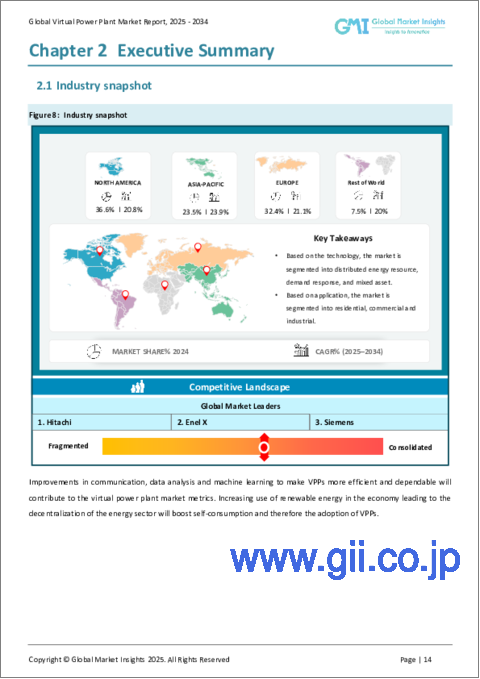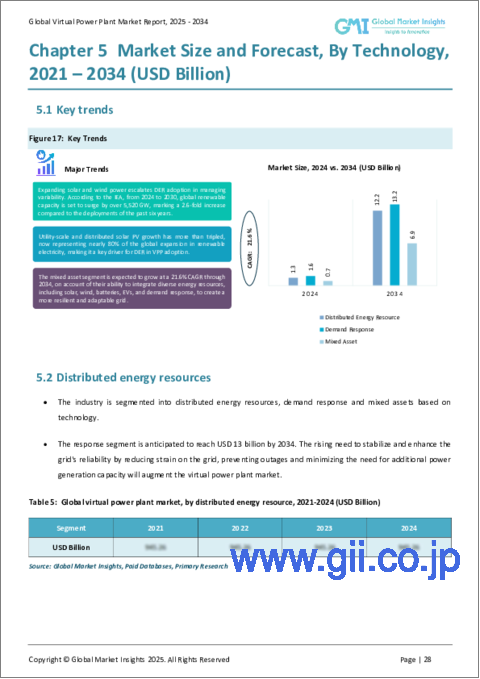|
|
市場調査レポート
商品コード
1665317
仮想発電所の市場機会、成長促進要因、産業動向分析、2025~2034年予測Virtual Power Plant Market Opportunity, Growth Drivers, Industry Trend Analysis, and Forecast 2025 - 2034 |
||||||
カスタマイズ可能
|
|||||||
| 仮想発電所の市場機会、成長促進要因、産業動向分析、2025~2034年予測 |
|
出版日: 2024年12月20日
発行: Global Market Insights Inc.
ページ情報: 英文 105 Pages
納期: 2~3営業日
|
全表示
- 概要
- 目次
世界の仮想発電所(VPP)市場は、2024年には46億米ドルに達すると予測され、2025~2034年のCAGRは21.6%と著しい成長率を遂げると予測されています。
VPPは、分散型の小規模発電ユニットを中央システムによって管理されるまとまったネットワークに統合することで、エネルギーセグメントに革命をもたらしています。分散型資源からのエネルギーを集約することで、これらの先進システムは生産、消費、配電を最適化し、単一の事業体としてシームレスに動作します。この革新的なアプローチは、送電網の安定性を高め、エネルギー効率を向上させ、資源管理を簡素化し、より信頼性が高くサステイナブルエネルギーエコシステムに貢献します。

VPP市場は、分散型エネルギー資源、需要応答、混合資産システムなど、主要な技術セグメントに分けられます。なかでも需要応答セグメントは、2034年までに130億米ドルを生み出すと予測されています。この成長の原動力となっているのは、送電網の信頼性を高め、停電を防止し、より費用対効果の高いエネルギー管理を可能にする機能です。デマンド・レスポンスシステムは、既存のインフラへの負担を軽減し、発電能力を追加する必要性を最小限に抑え、エネルギー効率を促進するのに役立ちます。手頃な価格で効率的なエネルギーソリューションへの需要が高まるにつれ、需要応答システムはVPPにとって不可欠な要素となり、よりダイナミックでサステイナブルエネルギーグリッドを実現しています。
| 市場範囲 | |
|---|---|
| 開始年 | 2024年 |
| 予測年 | 2025~2034年 |
| 開始金額 | 46億米ドル |
| 予測金額 | 322億米ドル |
| CAGR | 21.6% |
エンドユーザーに関しては、VPP市場は住宅用、産業用、商業用に分類されます。産業用セグメントは、2034年までCAGR 20.5%という驚異的な成長を遂げると予測されています。産業事業におけるエネルギー需要の増加が、エネルギー負荷のシフト、ピーク需要の削減、リアルタイムのエネルギー管理によってコストを削減できるソリューションの必要性を高めています。さらに、持続可能性目標や二酸化炭素排出削減への関心の高まりが、産業におけるVPPの採用を加速させています。産業部門では、継続的な操業をサポートするために、信頼性が高くエネルギー効率の高いシステムを優先する傾向が強まっており、VPPはエネルギー戦略の重要な一部となっています。
米国では、仮想発電所市場は2034年までに92億米ドルを生み出すと予測されています。インフラの老朽化、異常気象、エネルギー需要の増加による送電網の安定性維持という課題が、回復力を確保するためのVPP導入に拍車をかけています。再生可能エネルギーや蓄電技術に対する税額控除や補助金などの連邦施策は、VPP導入に有利な環境を作り出しています。これらの施策は、エネルギー安全保障を強化するだけでなく、住宅・産業両部門における高度電力管理システムの普及を促進します。
目次
第1章 調査手法と調査範囲
- 市場の定義
- 基本推定と計算
- 予測計算
- 一次調査と検証
- 一次情報
- データマイニングソース
- 市場定義
第2章 エグゼクティブサマリー
第3章 産業洞察
- 産業エコシステム
- 規制状況
- 産業への影響要因
- 促進要因
- 産業の潜在的リスク・課題
- 成長可能性分析
- ポーター分析
- 供給企業の交渉力
- 買い手の交渉力
- 新規参入業者の脅威
- 代替品の脅威
- PESTEL分析
第4章 競争情勢
- イントロダクション
- 戦略ダッシュボード
- イノベーションと持続可能性の展望
第5章 市場規模・予測:技術別、2021~2034年
- 主要動向
- 分散型エネルギーリソース
- 需要応答
- 混合資産
第6章 市場規模・予測:最終用途別、2021~2034年
- 主要動向
- 住宅用
- 産業用
- 商業用
第7章 市場規模・予測:地域別、2021~2034年
- 主要動向
- 北米
- 米国
- カナダ
- 欧州
- ドイツ
- フランス
- 英国
- イタリア
- アジア太平洋
- 中国
- 日本
- 韓国
- インド
- その他
第8章 企業プロファイル
- AGL Energy
- Bosch Global
- Enel X
- Enbala Power Networks
- Hitachi
- Tesla
- Statkraft
- Shell
- Siemens
- Schneider Electric
The Global Virtual Power Plant Market is anticipated to reach USD 4.6 billion in 2024 and is projected to experience a remarkable growth rate of 21.6% CAGR from 2025 to 2034. VPPs are revolutionizing the energy sector by integrating decentralized, small-scale power generation units into a cohesive network managed by a central system. By aggregating energy from distributed resources, these advanced systems optimize production, consumption, and distribution, operating seamlessly as a single entity. This innovative approach boosts grid stability, enhances energy efficiency, and simplifies resource management, contributing to a more reliable and sustainable energy ecosystem.

The VPP market is divided into key technological segments, including distributed energy resources, demand response, and mixed asset systems. Among these, the demand response segment is poised to generate USD 13 billion by 2034. This growth is driven by its capability to enhance grid reliability, prevent outages, and enable more cost-effective energy management. Demand response systems help reduce strain on existing infrastructure, minimizing the need for additional power generation capacity and promoting energy efficiency. As the demand for affordable and efficient energy solutions rises, demand response systems have become a vital component of VPPs, enabling a more dynamic and sustainable energy grid.
| Market Scope | |
|---|---|
| Start Year | 2024 |
| Forecast Year | 2025-2034 |
| Start Value | $4.6 Billion |
| Forecast Value | $32.2 Billion |
| CAGR | 21.6% |
When it comes to end users, the VPP market is categorized into residential, industrial, and commercial applications. The industrial segment is projected to grow at an impressive CAGR of 20.5% through 2034. Rising energy demands within industrial operations are driving the need for solutions that can lower costs by shifting energy loads, reducing peak demand, and providing real-time energy management. Additionally, the growing focus on sustainability goals and carbon emission reductions is accelerating the adoption of VPPs in industries. As industrial sectors increasingly prioritize reliable and energy-efficient systems to support continuous operations, VPPs have become an essential part of their energy strategies.
In the U.S., the virtual power plant market is forecast to generate USD 9.2 billion by 2034. The challenges of maintaining grid stability due to aging infrastructure, extreme weather events, and increasing energy demand are spurring the adoption of VPPs to ensure resilience. Federal policies, such as tax credits and grants for renewable energy and storage technologies, are creating a favorable environment for VPP deployment. These policies not only enhance energy security but also promote the widespread adoption of advanced power management systems in both residential and industrial sectors.
Table of Contents
Chapter 1 Methodology & Scope
- 1.1 Market definitions
- 1.2 Base estimates & calculations
- 1.3 Forecast calculation
- 1.4 Primary research & validation
- 1.4.1 Primary sources
- 1.4.2 Data mining sources
- 1.5 Market definitions
Chapter 2 Executive Summary
- 2.1 Industry synopsis, 2021 – 2034
Chapter 3 Industry Insights
- 3.1 Industry ecosystem
- 3.2 Regulatory landscape
- 3.3 Industry impact forces
- 3.3.1 Growth drivers
- 3.3.2 Industry pitfalls & challenges
- 3.4 Growth potential analysis
- 3.5 Porter's analysis
- 3.5.1 Bargaining power of suppliers
- 3.5.2 Bargaining power of buyers
- 3.5.3 Threat of new entrants
- 3.5.4 Threat of substitutes
- 3.6 PESTEL analysis
Chapter 4 Competitive landscape, 2024
- 4.1 Introduction
- 4.2 Strategic dashboard
- 4.3 Innovation & sustainability landscape
Chapter 5 Market Size and Forecast, By Technology, 2021 – 2034 (USD Billion)
- 5.1 Key trends
- 5.2 Distributed energy resource
- 5.3 Demand response
- 5.4 Mixed asset
Chapter 6 Market Size and Forecast, By End Use, 2021 – 2034 (USD Billion)
- 6.1 Key trends
- 6.2 Residential
- 6.3 Industrial
- 6.4 Commercial
Chapter 7 Market Size and Forecast, By Region, 2021 – 2034 (USD Billion)
- 7.1 Key trends
- 7.2 North America
- 7.2.1 U.S.
- 7.2.2 Canada
- 7.3 Europe
- 7.3.1 Germany
- 7.3.2 France
- 7.3.3 UK
- 7.3.4 Italy
- 7.4 Asia Pacific
- 7.4.1 China
- 7.4.2 Japan
- 7.4.3 South Korea
- 7.4.4 India
- 7.5 Rest of World
Chapter 8 Company Profiles
- 8.1 AGL Energy
- 8.2 Bosch Global
- 8.3 Enel X
- 8.4 Enbala Power Networks
- 8.5 Hitachi
- 8.6 Tesla
- 8.7 Statkraft
- 8.8 Shell
- 8.9 Siemens
- 8.10 Schneider Electric





